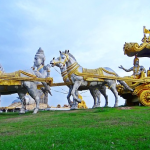It was a landslide victory for India at the UN General Assembly when the United Nations declared June 21st as International Yoga Day (or World Yoga Day). This came after Prime Minister Narendra Modi had urged the world community to celebrate yoga at the international level, in his maiden speech at the UNGA in September 2014. He had said, “yoga is an invaluable gift of our ancient tradition. It is not about exercise, it’s a path through which an individual can discover his sense of oneness with nature. It embodies unity, unity of the mind and the body, thought and action, restraint and fulfilment. On the whole, it’s a holistic approach to health and well being.”
Prepping for International Yoga Day
The resolution was prepared by India; informal consultations were convened in October by the Indian mission in the UN General Assembly, and views on the topic were expressed by other delegations. The idea of an International Yoga Day had garnered overwhelming support: 175 countries in the 193-member General Assembly had joined as co-sponsors as on December 9, 2014, the highest number of co-sponsors ever for any UNGA resolution. The initial official document circulated to the General Assembly, known as the L document, itself had 130 member states joining as co-sponsors, including the five permanent members of the Security Council, several Asian, European and Latin American countries and nearly 60 per cent of African nations. It could be concluded that India had managed to lay its golden paving stone to walk proudly through the gateways of the world and embrace yoga practitioners across the globe.
Overwhelming Support for International Yoga Day
Referring to the wholehearted support from the world over, India’s Permanent Representative, Asok Kumar Mukerji told the UNGA, “This is a testimony to the enthusiastic cross-cultural and universal appeal that yoga enjoys amongst members of the United Nations.” He expressed his hope that the impact of this resolution would give vent to India’s efforts in the area of global health. Through the resolution, adopted under the agenda of ‘Global Health and Foreign Policy,’ it acknowledged that practising yoga would be beneficial for the health of the world population and was adopted with ovation, without even going through the usual procedure of passing a vote. It is for the first time in the history of the UN that such a proposal has been recommended and implemented by any country in less than 90 days. Besides proclaiming June 21st as the International Yoga Day, the resolution invited all organisations of the UN system and other international and regional bodies to propagate the benefits of practising yoga and to observe the day in order to publicize it.
In his message on the passage of the resolution, UN Secretary General Ban Ki-moon said, “yoga can bring communities together in an inclusive manner that generates respect. The diverse benefits it brings”, he added, “includes helping people deal with stress in emergency situations.” UNGA President Sam Kahamba Kutesa congratulated Modi for taking the initiative, saying that the adoption of the resolution with overwhelming support demonstrated how both the tangible and unseen benefits of yoga appealed to people around the world.
“For centuries, people from all walks of life have practiced yoga, recognizing its unique embodiment of unity between mind and body. Yoga brings thought and action together in harmony, while demonstrating a holistic approach to health and well-being,” Portuguese Ambassador Alvaro Mendonca e Moura told the UNGA in a speech delivered on Kutesa’s behalf.
Messages on International Yoga Day Declaration
Renowned yoga teacher Baba Ramdev had also supported Modi in his move. Acclaiming the resolution he said, “By bringing yoga glory on the global stage, Modi has paid a tribute to the legacy of our erstwhile legendary Rishis. India owes its identity to yoga. This means honour to India and Indianness.”
In Haridwar, eminent yoga exponent Swami Chidanand Saraswati told the media: “Today is a historic day. It illustrates that people from all walks of life and all backgrounds are embracing yoga all over the world.” BKS Iyengar, one of great modern propagators of yoga was quoted: “yoga, an ancient but perfect science; deals with the evolution of humanity. Yoga means union – the union of body with consciousness and consciousness with the soul.” The reason why June 21st was suggested was because it is the Summer Solstice, and from the perspective of yoga, it marks the transition in the Sun’s celestial passage from north to south.
According to yogi and mystic, Sadhguru, speaking on the significance of International Yoga Day, “In the yogic lore, the first transmission of yoga by Shiva, the Adiyogi to his seven disciples, the Saptarishis is said to have been initiated on the first full moon after Summer Solstice, which is celebrated as Guru Poornima. This period, known as Dakshinayana is hailed as the phase when there is natural support for those pursuing spiritual practices.”
The declaration of International Yoga Day was welcomed by the 53,000-member Yoga Alliance. Barbara Dobberthien, its chief operating officer, said: “The Yoga Alliance was created to spread the power of yoga, and International Yoga Day provides us with another very powerful platform from which to support our mission.” Suhag Shukla, the Hindu American Foundation’s executive director, said: “In addition to gaining appreciation for one of India’s greatest contributions to the civilization, our hope is that this will introduce people around the world to its transformational power, its insistence on spiritual experience over dogma, its ability to make one realise the divine nature of man, and its power for bringing about both inner and outer peace.”
Why International Yoga Day Matters
Without a minimal understanding of yoga, it is difficult to appreciate the significance of the resolution to celebrate an International Yoga Day. The ancient sages of India had developed an integral system called yoga to keep the physical and mental faculties fit and healthy and to slow down the inevitable decay of the body organs. Yogic practices are complete in its revamping of the entire system – the physical body, the mental body and the energy body. Like every scientific theory; yoga also offers a very practical and systematically designed technique. The system of yoga maintains that every matter in this cosmos, from the most prevalent to the most subtle, is vibrant with life. Modern science agrees with it in that even inside the tiniest particle of atom, there is incredible movement. If there is movement, it is being caused by some energy and that energy, yoga stresses, is the basis of all life. According to yoga, each and every matter is throbbing with life energy – that energy is consciousness itself and that consciousness is just a part of the Super Consciousness or God Reality.
The same energy radiates forth from the lowest life form to the highest; it only varies in appearance. Man is considered to be the highest in the ladder of evolution because he is the only being whose awareness can be enhanced to the maximum level to reach the state of enlightenment, the stage where he identifies himself with the Super Consciousness. Yoga recommends that to reach that level, man has to attain the highest state of awareness or consciousness which can be accomplished by following a life structured on self discipline, based on the principles of a simple living and lofty thoughts, in which equal significance is given to the development of the physical, mental and energy bodies.
The physical body is meant to remain active. The lifestyle should be such that the muscles and joints obtain enough exercise, a kind of exercise that is not tiresome and at the same time, beneficial to the three bodies. Hatha yoga, in which the body is stretched to the maximum through slow movements and the specific time period with which each posture is maintained, is meant to increase one’s body flexibility. As long as the body is supple, it remains young. Yoga mainly focuses on the spine, the axis of the physical body, the main “telegraphic” pole from where the entire nervous system emerges. If the spine remains agile and strong, there will be no disruption over the blood circulation and an adequate supply of nutrients and oxygen will be delivered to the nerves to keep them receptive and healthy. As age begins to catch up, the shoulders get hunched over due to lack of exercise and one has painful tension in the upper part of the back and neck due to the various nerves that have gone out of shape. Hatha yoga corrects one’s posture, aiding him naturally to be alert and confident.
Prana is the vital force in the body. Pranayama is both a science and an art of purifying the channels along which the life stream of ‘prana’ flows. Pranayama, breathing practices, the process by which conscious control is achieved through synchronized breathing, are vital for increasing the capacity of the lungs. Through regulated breathing, by altering the rhythm of inhalation and exhalation, it is possible to control the prana. This kind of yogic breathing teaches a person how to use the lungs to their maximum capacity and how to control the breath. Deep, slow and rhythmical breathing increases vitality and mental clarity. Most people breathe shallowly, barely expanding the rib cage. Purifying the prana is a preventive as well as a curative measure against a variety of physical and mental ailments. It increases one’s overall immunity and resistance to diseases.
The body, mind and energies of an individual have to be in absolute harmony with the existence. Your creativity or your ability to perform depends upon the manner in which your energy functions. If you can gain some mastery over your energies, something like getting your batteries charged, there will be incomparable improvement in your performance without much extra effort from your side. Once you begin to activate your inner energies, your thought process, the swiftness with which your brain reacts and the implementations of your ideas happen in a different sphere altogether. There is a whole technology as to how to use this energy for higher possibilities and that is Kriya yoga.
The Benefits of Yoga
Whether you play a game or are busy in the work place, when there is perfect concentration, your participation is at its maximum, and productivity is at its best. This mental aptitude has to be developed. Man is forever running helter-skelter for a joyful existence, fulfilling his insignificant desires, hoping that it would offer him everlasting pleasure. All joys and gratifications in this world are momentary. To achieve that state of lasting happiness and absolute peace, the mind’s focus has to be turned inward, upon the self. When the mind is thus fully focused on the self, time does not even seem to exist and you don’t feel like coming out of that blissful state. That specific stage is called meditation. All yoga practices essentially culminate at meditation, wherein one attains a state of consciousness, free from all forms of dynamic or disruptive thoughts, and of eventually attaining a state wherein consciousness is oblivious of the external world and is only aware of its own nature as Consciousness.
But for that, the ever active mind has to be stilled, though it is very difficult to rein in the racing thoughts. If one is adamant enough to carry the memories of a sixty year old burden over one’s shoulders, thoughts relating to them and worries concerning the future, he would naturally look and feel old. On the other hand, if he could simply unburden all those illusory problems, he would remain like a child, happy and content. When man realises that in all its potentiality and learns to live in the present, the rubbish that hides his exceptionally potential mind from all probabilities is discarded progressively and in due course, flung off altogether. He would have learned to be the master of his mind. The yoga sadhanas are designed for that very purpose.
As he progresses in yoga, there is a big transformation in the individual though the world around him remains the same. His attitude towards life changes; he is able to free himself from all the entangling emotions and feelings that bind him to the world, he acquires a sense of detachment, all of which empowers him to still his mind and body, a prerequisite for meditation. On the physical level, meditation helps to prolong the body’s anabolic process of growth and repair, and to reduce the catabolic or decaying process. Ordinarily, the growth stage predominates until the age of 18, from then onward, until one is 35, there is balance between the two, and after that the catabolic process dominates. Meditation can significantly reduce the catabolic decline.
Man is forever curious about his life. Some of the lurking doubts like, “Who am I? What is the purpose of life? What happens to me after death?” are glaring at his face without any conceivable answer. Though the truth is buried right within every being, drowning under the intoxicating sea of materialism, he refuses to delve into his spirit to find an answer. If he wishes to explore the spiritual realms and seek the eternal truth, he should realise that in this manner, he would never reach the shore. He should plunge out of the harsh waters and gasping for the precious fresh air, he should swim against the waves using all his might, because the magnetic pull of the materialistic world can be too powerful and irresistible. Yoga is ultimately, the union of the self with the Divine. It assists you to float with ease on the harsh sea which suddenly seems to be placid, not because the sea has become calmer, but because your physical body has turned healthier, the mental body has become more tolerant and the energy body has been fully charged. You have, in essence learned to be truly loving and compassionate. Your inner being would have turned receptive enough to receive the grace that is forever being showered upon you though you are not even aware of it.
One cannot learn to meditate, anymore than one can learn to sleep. One has to fall into both stages. After disciplining the body through Hatha yoga, Pranayama and Kriya yoga, when the conditions are conducive, one gradually gains that skill. Through meditation, you reach a stage wherein there is no duality, no subject or object, where the knower, the knowledge and the known are united into one. This knowledge brings a feeling of oneness with the whole world. The individual becomes one with the Super Consciousness. It is this oneness that yoga is aiming at. As Jesus had proclaimed, “I am in ye, as you are in Me, I am He.”
International Yoga Day: 200 million and Beyond
It is estimated that close to 200 million people around the world practice yoga (of some form or the other), a majority of them in India, and over 20 million of them in the United States alone. With this resolution for an International Yoga Day, more people will become aware of the tenets of yoga and will be encouraged to follow a yogic life style, a life that is healthy, humble and devout. Let this be a great opening for the world community to realise the worth of oneness and then, there is no feud, no disagreement and no disparity. Man of every creed and colour will live as one – the world will become one.















